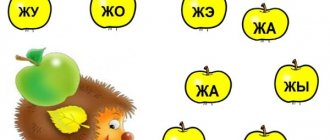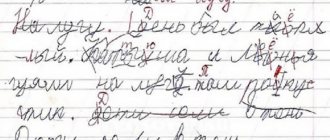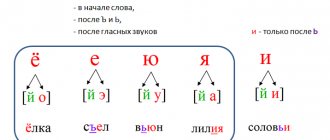Monosyllabic words
The vowel sound in a word is syllabic. A word has as many phonetic syllables as it contains vowel sounds. In accordance with the number of vowel sounds, we indicate monosyllabic words
:
- world;
- paradise;
- house;
- catfish;
- treasure;
- flag;
- ford;
- tail.
Words and phrases starting with the syllable “La”.
IRSHAT ZIANBERDIN
BRIEF ACADEMIC (DOCUMENTARY) EXPLANATORY DICTIONARY OF THE BASHKIR LANGUAGE.
Book "Ll".
MRAKOVO – 2020
UDC 81'374
BBK 81.632.2
Z-59
Zianberdin I.B.
BRIEF ACADEMIC (DOCUMENTARY) EXPLANATORY DICTIONARY OF THE BASHKIR LANGUAGE. Book "Ll". 1st edition. Reference book. – Mrakovo, 2022. – 19 pages.
© Zianberdin.I.B., 2022.
FROM THE AUTHOR
This book is written based on the experience gained by the author when writing the books “Explanatory Dictionary of Bashkir Languages” and “Ancient Bashkir Scripts. The author's explanatory dictionary of the vocabulary of little-studied artifacts, which, due to the small circulation, have become inaccessible to most researchers and local historians.
The purpose of this work is to create a manual based on documentary sources of Historical Bashkortostan, known to date, for researchers in the field of humanities and socio-legal sciences.
The book consists of the vocabulary of historical Bashkir languages, recorded in writing in documents from the archival funds of various subjects of the Federation, now located in the former territories of historical Bashkortostan, the boundaries of which were determined by us based on the text of the charter of Genghis Khan issued to Muyten-bek, recorded in the Bashkir chronicles and published in the works of Kadergali Zhalairi.
Transcription - “Auul Ak Adilng bashindan tmagina sakli Ak Aidlga kuigan auzinlr brle hm aurman u ilgalari aile hm Aural tauing gunchgch iagi Auralga iakin Aishim kushilgan sulr (brle) Irman Irtsh digan auzinlr auzinlrga kuilgan barcha ilgalari aur man u ilan aile ine Iaig bashi Zhalpi taulri Iaign aiki iagi iir Iaigng gunchgch iagi Tubl suina chakli hm Iaigka kuigan ni bari suvlr hm auznlr hm aurmnlri u ilanlri aile Tuksaba auranli bashkrtlrga kuchb iailagan aultrin kishlak aurinlrin mnglig aitb virldi.”
Translation into Russian - “First from the source to the mouth of the Ak Idili (Belaya) river with all the rivers, forests and valleys flowing into the Ak Idili, and the eastern side of the Ural Mountains. Close to the Urals are the Ishim River with all its tributaries, the Irman (Ob) and the Irtysh with all its tributaries and forests and glades. Even in the upper reaches of the Yaik, the Chelyabinsk Mountains, both banks of the Yaik (Ural River), the eastern lands of the Yaik to the Tubyl River with all the tributaries of the Yaik, with forests, glades were forever granted to the Bashkirs with “Tuksaba” uranium for nomadism, for summer and wintering grounds.”
Like any language in the world, the Bashkir language, as a living thing, develops in time and space and is recorded throughout its history by various letters used by our people in different periods of its development. Although the “Bashkort” people were first recorded on the world map of Hecataeus of Miletus in the 7th century BC directly in Bashkir documents, the self-name of the people was first mentioned in the stone letter of Mode-Shanu in the 2nd century BC.
Transcription - “Kaznab. Amadch, amnchb, dkmadeash buashkrdma tslm abdanch. Made."
Translation into Russian – “Stored place. I gave my uterine, same-tribal, only-begotten people “Bashkort” a place of permanent residence. Made."
Since the time of Mode-Shanyu, the Bashkirs professed the teachings of many prophets, adhered to the teachings of many religions such as Maitreya-Buddha-Zoroastr-Moses-Jusus-Mani-Muhammad and used the scripts inherent in the religions that were founded by the prophets listed above.
Until the 7th century AD, the ancestors of the Bashkirs bore the ethnonym “ishdk”. In those distant times, the ancestors of our people used Kanglin hieroglyphs-numbers-heterograms, which were replaced by the Kharostha script and runes.
In this book you will find all the words and phrases documented by the writings of our people in time and space from ancient times to 1940, which we found at the time of writing the book.
We express our gratitude to the participants of the group “Virtual Archive of Ancient Acts of Bashkortostan”, its branches and libraries, in the “VKontakte” server. I express special gratitude to the Bashkir academician, Doctor of Philology, Khusainov Gaisa Batyrgareevich, for the moral support of all endeavors in the acquisition and study of documents from the Archival Fund of Bashkortostan.
Letter – Ll
Ll is the seventh letter of the historical Bashkir alphabets.
In texts with Arabic script it is written in the form “
».
In other Bashkir writings it is indicated by the following graphemes:
— In the Latin alphabet of the Bashkir language – “
" It is known to be used in Bashkortostan from the 3rd century AD to the 40th year of the 20th century AD.
— In Bashkir texts, the Kharoshthi script is written like this: “”. From the 28th century BC to the 4th century AD.
— In Bashkir texts, the Brahmi script is written like this: “”. From the 8th century BC to the 8th century AD.
— In the texts, in Georgian-Kipchak writing it is designated as “”. It is known to be used in Bashkortostan from the 10th century AD to the 13th century AD.
- In the Khazarian written Bashkir texts it is written as follows -
" ". It is known to be used in Bashkortostan from the 9th century AD to the 12th century AD.
- In Uyghur written texts it is indicated by the following graphemes -
«
" It is known to be used in Bashkortostan from the 8th century AD to the 19th century AD.
— In Bashkir texts written using the Thalassian-Syrian script, this letter is designated as “”. Known to be used from the 7th century BC to the 11th century AD.
— In Bashkir texts written in the Jacobite serto script, this letter is designated as follows: “”. Known to be used from the 5th century AD to the 11th century AD.
-In Bashkir texts written in the Yunan script of the 7th-11th centuries. is indicated by the following signs – “ ”.
— In Bashkir texts written in Aramaeo-Syrian scripts, the letter “Ll” is designated as follows: “
" It is known to be used in Bashkortostan from the 7th century BC to the 10th century AD.
In texts with the Armenian-Kipchak script, the letter “Ll” is designated as follows: “”.
In texts with the Yunan-Kipchak script, the letter “Ll” is designated as follows:
« ».
In texts with the Cathay script, the letter “Ll” is designated as follows: “ ; "
Bashkir texts with the nagari letter “Ll” are written like this “”.
In runic Bashkir texts, the letter is written like this - “”.
4.
IRSHAT ZIANBERDIN
BRIEF ACADEMIC (DOCUMENTARY) EXPLANATORY DICTIONARY OF THE BASHKIR LANGUAGE.
Book "Ll".
MRAKOVO – 2020
UDC 81'374
BBK 81.632.2
Z-59
Zianberdin I.B.
BRIEF ACADEMIC (DOCUMENTARY) EXPLANATORY DICTIONARY OF THE BASHKIR LANGUAGE. Book "Ll". 1st edition. Reference book. – Mrakovo, 2022. – 19 pages.
© Zianberdin.I.B., 2022.
FROM THE AUTHOR
This book is written based on the experience gained by the author when writing the books “Explanatory Dictionary of Bashkir Languages” and “Ancient Bashkir Scripts. The author's explanatory dictionary of the vocabulary of little-studied artifacts, which, due to the small circulation, have become inaccessible to most researchers and local historians.
The purpose of this work is to create a manual based on documentary sources of Historical Bashkortostan, known to date, for researchers in the field of humanities and socio-legal sciences.
The book consists of the vocabulary of historical Bashkir languages, recorded in writing in documents from the archival funds of various subjects of the Federation, now located in the former territories of historical Bashkortostan, the boundaries of which were determined by us based on the text of the charter of Genghis Khan issued to Muyten-bek, recorded in the Bashkir chronicles and published in the works of Kadergali Zhalairi.
Transcription - “Auul Ak Adilng bashindan tmagina sakli Ak Aidlga kuigan auzinlr brle hm aurman u ilgalari aile hm Aural tauing gunchgch iagi Auralga iakin Aishim kushilgan sulr (brle) Irman Irtsh digan auzinlr auzinlrga kuilgan barcha ilgalari aur man u ilan aile ine Iaig bashi Zhalpi taulri Iaign aiki iagi iir Iaigng gunchgch iagi Tubl suina chakli hm Iaigka kuigan ni bari suvlr hm auznlr hm aurmnlri u ilanlri aile Tuksaba auranli bashkrtlrga kuchb iailagan aultrin kishlak aurinlrin mnglig aitb virldi.”
Translation into Russian - “First from the source to the mouth of the Ak Idili (Belaya) river with all the rivers, forests and valleys flowing into the Ak Idili, and the eastern side of the Ural Mountains. Close to the Urals are the Ishim River with all its tributaries, the Irman (Ob) and the Irtysh with all its tributaries and forests and glades. Even in the upper reaches of the Yaik, the Chelyabinsk Mountains, both banks of the Yaik (Ural River), the eastern lands of the Yaik to the Tubyl River with all the tributaries of the Yaik, with forests, glades were forever granted to the Bashkirs with “Tuksaba” uranium for nomadism, for summer and wintering grounds.”
Like any language in the world, the Bashkir language, as a living thing, develops in time and space and is recorded throughout its history by various letters used by our people in different periods of its development. Although the “Bashkort” people were first recorded on the world map of Hecataeus of Miletus in the 7th century BC directly in Bashkir documents, the self-name of the people was first mentioned in the stone letter of Mode-Shanu in the 2nd century BC.
Transcription - “Kaznab. Amadch, amnchb, dkmadeash buashkrdma tslm abdanch. Made."
Translation into Russian – “Stored place. I gave my uterine, same-tribal, only-begotten people “Bashkort” a place of permanent residence. Made."
Since the time of Mode-Shanyu, the Bashkirs professed the teachings of many prophets, adhered to the teachings of many religions such as Maitreya-Buddha-Zoroastr-Moses-Jusus-Mani-Muhammad and used the scripts inherent in the religions that were founded by the prophets listed above.
Until the 7th century AD, the ancestors of the Bashkirs bore the ethnonym “ishdk”. In those distant times, the ancestors of our people used Kanglin hieroglyphs-numbers-heterograms, which were replaced by the Kharostha script and runes.
In this book you will find all the words and phrases documented by the writings of our people in time and space from ancient times to 1940, which we found at the time of writing the book.
We express our gratitude to the participants of the group “Virtual Archive of Ancient Acts of Bashkortostan”, its branches and libraries, in the “VKontakte” server. I express special gratitude to the Bashkir academician, Doctor of Philology, Khusainov Gaisa Batyrgareevich, for the moral support of all endeavors in the acquisition and study of documents from the Archival Fund of Bashkortostan.
Letter – Ll
Ll is the seventh letter of the historical Bashkir alphabets.
In texts with Arabic script it is written in the forms “”.
In other Bashkir writings it is indicated by the following graphemes:
- In the Latin alphabet of the Bashkir language - “”. It is known to be used in Bashkortostan from the 3rd century AD to the 40th year of the 20th century AD.
— In Bashkir texts, the Kharoshthi script is written like this: “”. From the 28th century BC to the 4th century AD.
— In Bashkir texts, the Brahmi script is written like this: “”. From the 8th century BC to the 8th century AD.
— In the texts, in Georgian-Kipchak writing it is designated as “”. It is known to be used in Bashkortostan from the 10th century AD to the 13th century AD.
- In the Khazarian written Bashkir texts it is written as follows -
" ". It is known to be used in Bashkortostan from the 9th century AD to the 12th century AD.
- In Uyghur written texts it is indicated by the following graphemes -
" ". It is known to be used in Bashkortostan from the 8th century AD to the 19th century AD.
— In Bashkir texts written using the Thalassian-Syrian script, this letter is designated as “”. Known to be used from the 7th century BC to the 11th century AD.
— In Bashkir texts written in the Jacobite serto script, this letter is designated as follows: “”. Known to be used from the 5th century AD to the 11th century AD.
-In Bashkir texts written in the Yunan script of the 7th-11th centuries. is indicated by the following signs – “ ”.
— In Bashkir texts written in Aramaeo-Syrian scripts, the letter “Ll” is designated as “”. It is known to be used in Bashkortostan from the 7th century BC to the 10th century AD.
In texts with the Armenian-Kipchak script, the letter “Ll” is designated as follows: “”.
In texts with the Yunan-Kipchak script, the letter “Ll” is designated as follows:
« ».
In texts with the Cathay script, the letter “Ll” is designated as follows: “ ; "
Bashkir texts with the nagari letter “Ll” are written like this “”.
In runic Bashkir texts, the letter is written like this - “”.
Words and phrases starting with the syllable “La”.
| No. | Historical Bashkir words and explanations for them |
| 1 | - Arabic written spelling of the phrase “la alh ala alh” with the meaning “there is no God but God” from the text of the seal of Tukhtamysh Khan. Now used as " " with the same meaning. Dating: 1380 -1406 AD. |
| 2 | — kharoshthi written spelling of the word “lauga” with the meaning “great” from the text of the epitaph of the Kugersen Kuz burial ground in the Uchalinsky district. Now used as " " with the same meaning. Dating: From the 28th century BC to the 4th century AD. |
| 3 | - writing the word “lale” with the meaning “educator” in Aramaic-Syrian script from the texts of the kumbazs of the villages of the Zianchurinsky district. Now it is used only as the name of a flower and as an anthroponym "" with the same meaning. Dating: II-VI centuries AD. |
| 4 | - Bakhmi written spelling of the word “lalae” with the meaning of “educator” from the text of the press of the Ilishevsky district. Now used as an anthroponym "" with a similar meaning of "educator". Dating: from the 8th century BC to the 8th century AD. |
| 5 | - Brahmi written spelling of the word "la" with the meaning "". Not currently used. Dating: from the 8th century BC to the 8th century AD. |
| 6 | - Arabic written spelling of the word “la” with the meaning “no; except" from the text of the epitaph of the village of Sayran, Ishimbay district, based on a photograph by Khaidar Zinnatullin. Now used only in religious texts. Dating: 1455 AD. |
| 7 | - “Lan” is a word with the meaning “friendly; smile on the face" from the text of the village of Staro Subkhankulovo, Burzyansky district, written using the Jacobite serto script. Dating: from the 5th century AD to the 11th century AD. Now used only as the word "" with the meaning "grin; snideness." |
| 8 |
|
| 9 |
|
Two-syllable words
Words containing two vowel sounds in their phonetic form are disyllabic
, For example:
- ear;
- bro-juice;
- wing;
- whisper;
- barn.
Hyphenation of two-syllable words
These two-syllable words can be moved from one line to another
, using their phonetic division into syllables.
In the Russian language there are a number of disyllabic words, which, although they have two phonetic syllables, still, according to the spelling rules of word transfer
, cannot be moved from one line to another. This discrepancy between the phonetic division of words into syllables and the impossibility of their orthographic transfer occurs in cases where a vowel forms the first or second independent syllable alone, for example:
- coal;
- fairy.
According to the spelling rule, one letter does not remain on the first line and is not transferred to the next line, even if it denotes an independent phonetic syllable. These two-syllable words cannot be moved from one line to another
. They are written entirely on a line.









